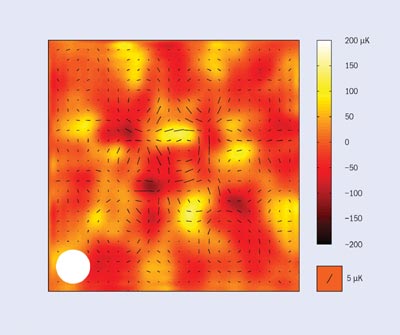
Another big step forward has been made in the study of the early universe. The Degree Angular Scale Interferometer (DASI) has announced the first measurements of the polarization of cosmic microwave background (CMB) radiation. The new results are a strong validation of the theoretical framework for the origin of fluctuations in the CMB, and also lend confidence to the values of the cosmological parameters that have been derived from CMB measurements.
CMB radiation dates from 300 000 years after the Big Bang, when radiation decoupled from matter. Fluctuations in the CMB are evidence for the first clumping of matter particles – the seeds of the galaxies that we see today. The radiation is polarized because atoms moving in the early universe scattered light differently, depending on whether the light was heading towards or away from them. The faster the speed of the atoms, the more pronounced the polarization. Measuring the polarization of the CMB is a direct measure of the dynamics of the early universe.

This exciting field of study has seen many advances in observing capabilities over recent years, and new discoveries have been coming thick and fast. Just last year, DASI and also the BOOMERANG balloon experiment announced measurements of the angular power spectrum of the CMB. Plotting the observed power as a function of the angular size of emitting regions gives a constraint on cosmological parameters, such as W – the ratio of matter in the universe to the critical level needed to halt its expansion, and also the amount of ordinary matter and dark matter in the universe. The polarization signal is more difficult to detect. For the temperature measurements, 32 different areas of the sky were observed for relatively short time scales. For the polarization measurements, 271 days of observation were needed for just two areas of sky to reach the required signal level.
DASI is a 13-element interferometer located at the south pole. Observers and the telescope must survive freezing antarctic conditions, not without difficulties. However, their endurance has certainly paid off, with some extremely interesting results.








